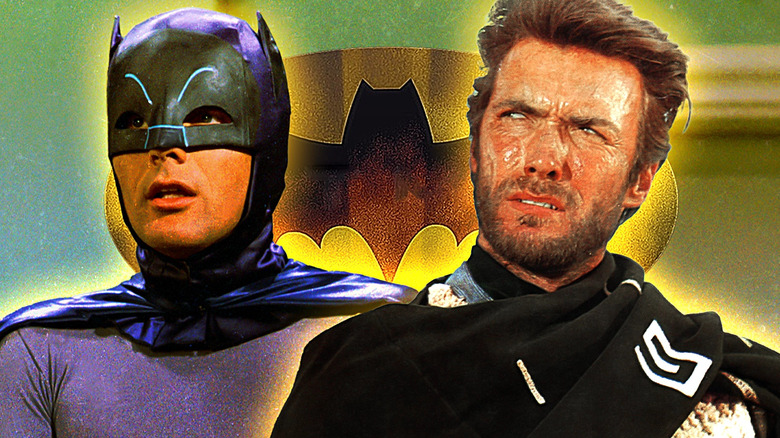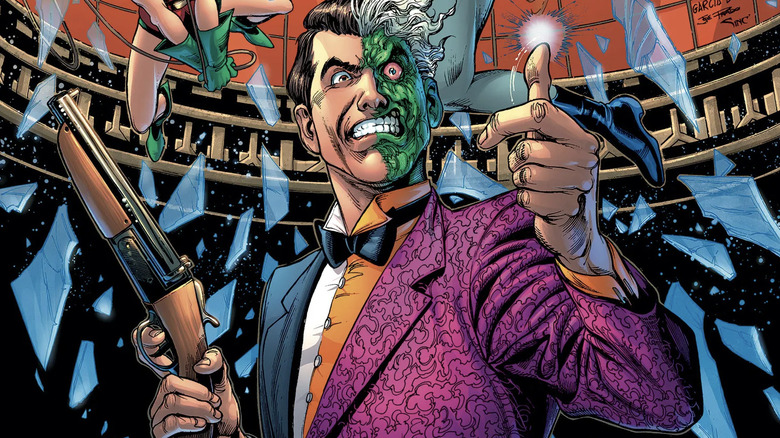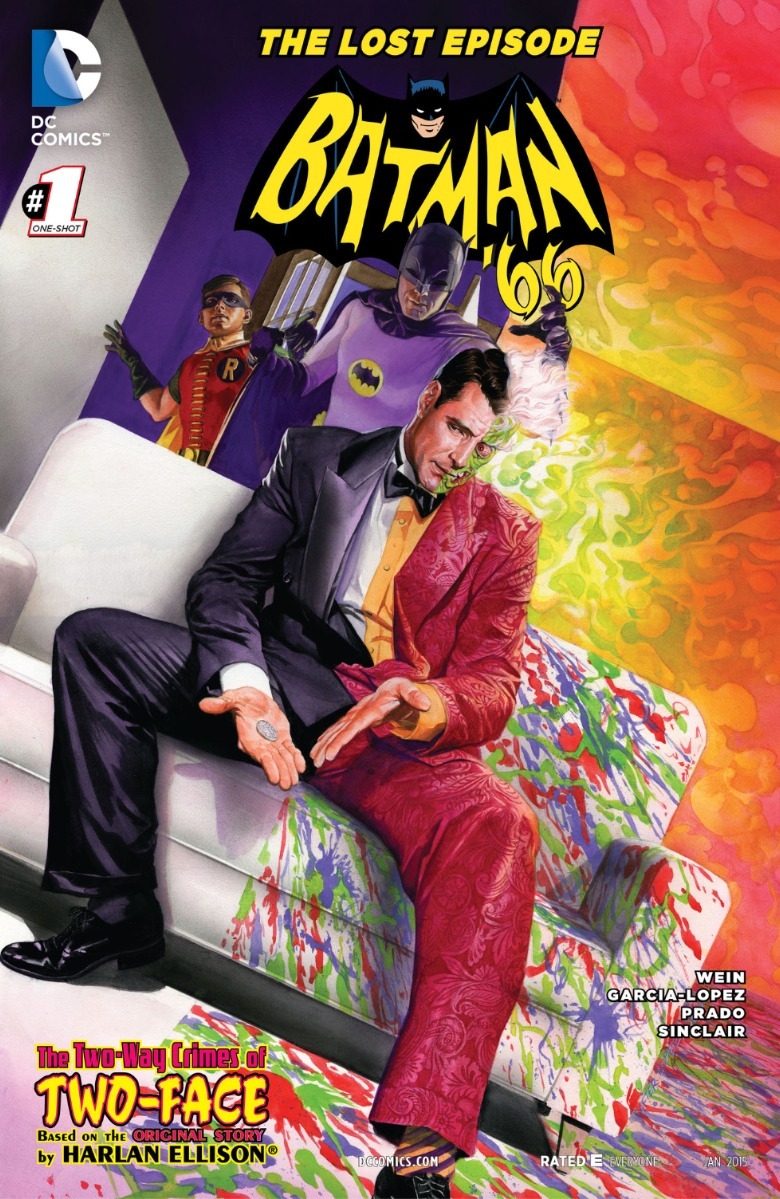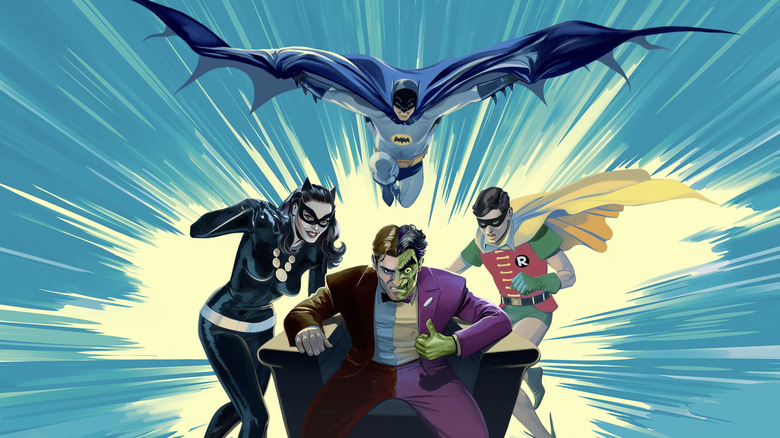Clint Eastwood Could Have Played A Huge Batman Villain In A Canceled Episode
We may receive a commission on purchases made from links.
Batman has one of the most enviable ensembles of recurring villains in superhero comics. Look back at the 1960s "Batman" TV series starring Adam West, though, and not a lot of those now familiar evildoers are there.
Oh, for sure, the Joker (Cesar Romero), the Riddler (Frank Gorshin, with one exception), Catwoman (Julie Newmar, Lee Meriwether, and Eartha Kitt), and the Penguin (Burgess Meredith) all frequently guest star. It's because of the West series that this crew was long considered the Big Four of Batman villains; it's no coincidence that they were also the first four villains to star in the Tim Burton/Joel Schumacher-directed "Batman" films.
Then you had some other comic villains, like Mr. Freeze and the Mad Hatter, put in a few appearances too. But many episodes of "Batman" instead had West's Caped Crusader and Robin (Burt Ward) face villains created specifically for the show, including wannabe pharaoh King Tut (William Omaha McElroy), Egghead (played Vincent Price himself), the cowboy-themed Shame (Cliff Robertson), and so on.
Admittedly, some of the most famous Batman villains hadn't been created yet, like Ra's al Ghul, Killer Croc, Bane, and Harley Quinn (who would debut decades later on "Batman: The Animated Series"). But the show left out some existing adversaries too, like Scarecrow, Clayface, Killer Moth, and Two-Face.
Harvey Dent aka Two-Face, as it were, debuted in 1942's "Detective Comics" #66, so he was plenty well-established by the time "Batman" hit television screens across America. At least the show considered using Two-Face, though. But who would've played Harvey Dent opposite West and Ward's Dynamic Duo? The long-standing rumor is a young Clint Eastwood, who'd recently wrapped up a series-long tenure on the Western program "Rawhide" and made the jump to movie star by appearing in Sergio Leone's "Dollars" trilogy.
Harlan Ellison's unmade Batman script pit the Caped Crusader against Two-Face
The idea of Eastwood playing Two-Face has been swirling on the internet since at least 2006. Giving the rumor some credence, pop culture historian Martin Grams wrote in 2011 that, were "Batman" to have been picked up for a fourth season, "Two-Face would have almost become a certainty [to appear] and consulting the production paperwork, it appears Clint Eastwood was slated for the role!"
In the biography "American Rebel: The Life of Clint Eastwood," author Marc Eliot claimed that Eastwood had accepted an offer from the "Batman" producers to play Two-Face. However, nothing was shot before the series was canceled. Sorry, Bat-fans, but there is definitely not any lost footage of Eastwood, made up as Two-Face, dueling with the Dynamic Duo.
Grams also claimed there were "a number of plot proposals" for "Batman" episodes featuring Two-Face. "Batman" associate producer Charles B. Fitzsimons claimed in one 1966 interview that Two-Face would appear on the show, reimagined as a TV anchor who was scarred by an exploding television set.A full two-part script featuring Two-Face, written by Peter Rabe, was titled "The Two-Faced Counterfeit and The Counterfeit Counterfoiled."
Famous science-fiction writer Harlan Ellison also pitched a Two-Face episode for "Batman," titled "The Two-Way Crimes of Two-Face." Why wasn't it produced? Ellison had previously gotten into a fist fight with Adrian Samish, ABC's Broadcast Standards and Practices, who in turn blacklisted Ellison from working at the network.
However, Ellison eventually released his episode outline for "The Two-Way Crimes of Two-Face" in 2013. The outline was part of his five volume anthology, "Brain Movies: The Original Teleplays of Harlan Ellison." The following year, DC Comics turned the outline into a one-shot comic, "Batman '66: The Lost Episode" #1, scripted by the late Len Wein with cover art by Alex Ross and interior pencils from José Luis Garcia-Lopez.
(Similarly, Ellison's original script for the "Star Trek" episode "The City on the Edge of Forever" was also made into a comic in 2014.)
Later tales of Batman vs. Two Face
Wein's dialogue is ripe with alliteration and puns, mimicking the scripting of the '60s "Batman" show. The comic and original outline employ Two-Face's typical origin as Gotham's former District Attorney and emphasize the villain's dual nature. Two-Face flips his coin to dictate whether he behaves morally or evilly, which Ellison compares to Doctor Jekyll and Mr. Hyde in his pitch. So, at the story's climax, Batman (who swapped out the coin with a trick one) dares Two-Face that, if the coin lands on its edge, he'll surrender. Two-Face takes the bet and, lo and behold, Batman calls it right.
Said climax takes place on an antique pirate ship. In a presumed coincidence, this is similar to Dennis O'Neil and Neal Adams' famous Two-Face story "Half An Evil" in "Batman" #234, which was published later in 1971. This story reintroduced Two-Face after he'd been largely absent from '60s Batman comics; if he'd gotten onto the show, he might well have come back even sooner.
To be sure, Two-Face would've fit right in on "Batman." His design might've been a tad gruesome, but his obsession with the number two would fit in with the gimmick crimes often seen on "Batman." Plus, as Ellison's script shows, the coin-flipping and Two-Face's capacity for good allows him to play mind games with Batman.
Would Eastwood have been the right pick, though? He's always been a taciturn and stoic actor, so it's hard to picture him going as big and campy as the other "Batman" villains. In the 2017 animated film "Batman vs. Two-Face" (starring West and modeled on his Batman show), Two-Face is instead played by and modeled on William Shatner. If any actor could've outmatched West's Batman, it'd be Captain Kirk himself.
If anything, Eastwood would've probably been better casting to play Batman himself — a role which, later in life, he was also considered for.



